The last thing you want is to end up a shivering mess after 10 minutes of surfing or paddle boarding.
That’s why it’s a good idea to wear a wetsuit if you’re going to be in cold water.
With this guide featuring everything you need to know about wetsuits, you’ll be able to pick out the right one with ease.
Our Picks: Best Wetsuits for the Money
| PHOTO | WETSUIT | NOTES | ||
|---|---|---|---|---|
|
Editor’s Pick For Men
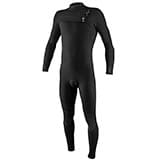 |
Editor’s Pick for Men
|
O’Neill 4/3+ Hyperfreak Chest Zip Wetsuit
|
|
Best Price at evo |
|
Editor’s Pick For Women
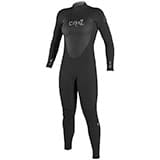 |
Editor’s Pick For Women
|
O’Neill 4/3 Epic Back Zip Wetsuit – Women’s
|
|
Best Price at evo |
|
Runner Up
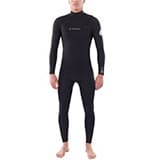 |
Runner Up
|
Rip Curl 3/2 Dawn Patrol Chest Zip Wetsuit – Mens & Womens
|
|
Best Price at Backcountry |
|
Runner Up
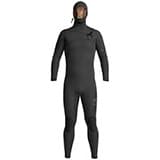 |
Runner Up
|
XCEL 4.5/3.5 Comp X Hooded Wetsuit – Mens & Womens
|
|
Best Price at evo |
The Benefits of a Wetsuit
The most significant benefit when it comes to a wetsuit is that it will keep you much warmer in the water.
Wetsuits are made from neoprene and rubber materials, and that material traps a thin layer of water between your body and the suit.
Your body temperature warms that layer of water, which in turn keeps you warmer while you swim and surf.
Technically, the layer of water slows down the loss of your body heat.
The material of the wetsuit also provides a bit of extra buoyancy, so you don’t need to work as hard to stay afloat.
The design of a wetsuit reduces drag helps keep your body in the proper swimming position and it reduces drag.
These benefits combined with the added buoyancy you get when wearing a wetsuit enable you to swim more easily.
Not only will you be able to swim more quickly, you’ll also expend use energy while doing so.
Wetsuit Styles
There are several different styles of wetsuits available, with the best style for you depending on the conditions where you’ll be wearing your wetsuit.
Here are the most common wetsuit styles:
Full Suit
The full suit covers your entire body, including your arms and legs.
It doesn’t cover your head, your hands or your feet.
Since it offers the most coverage, this wetsuit will provide the most warmth, making it the optimal choice if you plan to swim in very cold waters.
This wetsuit style is the most expensive option, and if you go with a thick full suit, you will have a bit more difficulty paddling.
Spring Suit
The spring suit covers your entire body, and it has either short-sleeve coverage on your arms and full coverage on your legs, or full coverage on your arms and short coverage on your legs.
Which style you choose comes down to personal preference as far as whether you’d like your arms or your legs exposed.
This wetsuit style provides a moderate amount of warmth, so it won’t be sufficient for very cold water.
Short-Arm Steamer
The short-arm steamer is similar to the short-sleeve spring suit, as it has full body and leg coverage, along with coverage of the upper arms.
The forearms are left exposed.
With its design, this wetsuit style keeps you warmer than the spring suit, and by keeping half of each arm exposed, it’s easier to paddle in this suit than it is in a full suit.
Long John
The Long John wetsuit covers your entire body and legs without covering your arms at all.
You’ll be able to paddle without any trouble, while staying moderately warm.
This wetsuit style works well when it’s warm outside but the water is cold, which is common in California during the summer.
Short John
The Short John wetsuit provides the same coverage as the Long John wetsuit, except it only covers the top half of your legs down to about your knees.
Since the design is so similar to the Long John wetsuit, it also provides similar benefits.
Jacket
The jacket wetsuit covers your upper body and your arms without any leg coverage.
You can wear these with a pair of board shorts or another type of swim trunk if you’re only concerned with keeping your upper body warm.
Rash Guard
A rash guard typically also covers your upper body and your arms, so it looks almost the same as a jacket wetsuit.
However, rash guards don’t provide the same level of warmth as a jacket wetsuit, and instead their main purpose is protecting you from chafing, rashes and the UV rays of the sun.
You can layer a rash guard under a full suit if you’ll be in very cold water and want extra warmth.
Vest
The vest wetsuit covers only your body, leaving your arms and legs exposed.
It won’t impair your paddling at all, but it also won’t provide much warmth due to the lack of coverage.
This wetsuit style is primarily for use on warm days when you just want a bit of extra heat for your core.
Dry Suit
Technically, a dry suit is in a different category than a wetsuit, but it’s good to know the difference.
Like the same suggests, a dry suit keeps you completely dry, as it has rubber seals on its neck, wrist and ankle areas.
They tend to have a looser fit that allows you to wear layers of clothing underneath the suit.
These suits are intended for use in very cold water and are most commonly used by cold-water divers, as a wetsuit may not provide enough heat in that situation.
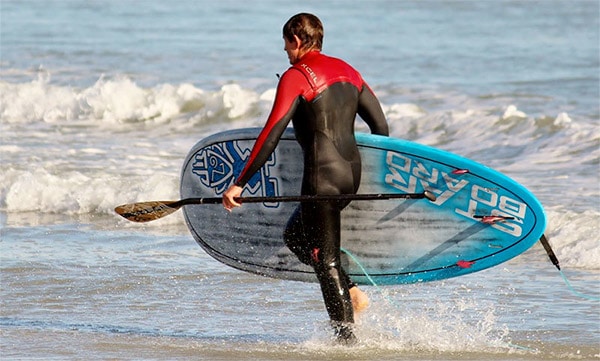
Common Wetsuit Accessories
There are also a few accessories that you can add to your wetsuit. While these are technically optional, we think you’ll definitely want some of these if you’re out doing some cold water surfing.
- Hood – A hood covers everything but your face, so your head stays warmer. There are wetsuits that have hoods attached to them, or you can get a hood on its own and attach it to your wetsuit.
- Gloves – These will cover your hands and fingers to keep them warmer. There are glovers available at varying thicknesses depending on how much warmth you need.
- Booties – These cover your feet to provide additional stability and to keep them warm. Like gloves, wetsuit booties are available at varying thicknesses. There are two main styles of booties: round toe and split toe. Round toe has one open space that you slip your foot inside, while split toe has a space for your big toe and a space for your other toes.
You would typically use these accessories in very cold water and wear them with a full suit, although you can also use them anytime if you find that your head, hands or feet tend to get cold while in the water.
Types of Seams
A wetsuit has panels of neoprene that are stitched together along seams.
Since seams don’t have the flexibility of sheet neoprene, the seams on a high-quality wetsuit will be away from any areas where flexibility is important.
This includes the shoulders and arms, since those areas will have quite a bit of movement while you’re paddling.
The seams on your wetsuit are very important, because if they don’t hold, water can get through them, at which point your wetsuit won’t keep you warm anymore.
Wetsuits with fewer seams are generally preferred because they provide minimal loss of flexibility and a lower chance of water getting into the suit.
While more seams can lead to a better fit, advancing neoprene technology has allowed manufacturers to create wetsuits that fit very well even with fewer seams.
There are several different types of seams that wetsuit manufacturers use.
- Overlock Stitching – Two ends of separate neoprene panels are rolled together and then stitched, which results in much less flexibility and causes an uncomfortable bulge inside the wetsuit. While overlock stitching is the simplest and least expensive type of seam, it also has the most drawbacks and the least effective when it comes to keeping water out of the suit, so this is only seen on lower-end wetsuits.
- Flatlock Stitching – The edge of one neoprene panel lays over the edge of another, and then the panels are stitched together. This seam provides plenty of flexibility and a strong, secure hold, but the stitching results in quite a few holes which allow water into the suit.
- Blind Stitching – The edges of two neoprene panels glued together and then stitched, however the stitching doesn’t penetrate to through the outside of the panels. This creates a flexible seam that is also watertight. High-quality wetsuits typically have this type of seam. If it’s a thicker wetsuit, it may have double blind stitching, which is where the seam has blind stitching on both sides.
Another way for manufacturers to prevent water from getting into the suit is by applying tape to the seam.
Manufacturers can use liquid tape on both the inside and outside of stitching to make it watertight.
Another option is neoprene tape, which manufacturers can apply on the inside of seams for a watertight seal that is also highly flexible.
Types of Zippers
There are three common zipper options with wetsuits.
As you compare the various models on the market, here’s what you will see when it comes to zipper styles:
- Back Zipper – A back zipper runs vertically along the back of the suit. While you can take the suit off easily and quickly with a back zipper, this type of zipper also makes the suit more rigid, so it’s a bit harder to move around.
- Chest Zipper – A chest zipper runs horizontally across the upper chest area of the suit. You can’t slip in and out of suits with chest zippers as quickly, but they do have significantly more flexibility than suits with back zippers.
- Zipper Free – This type of wetsuit will have flexible liners and Velcro closures. This maximizes the flexibility of the suit and prevents water from coming in more effectively than a suit with a zipper would. However, it will take longer to get in and out of the suit.
Thickness and Warmth Explained
One of the most daunting parts of buying a wetsuit is looking at product names and seeing different numbers and often slash marks.
Fortunately, once you know how wetsuit thicknesses work, it’s fairly simple to understand those numbers.
Thickness measurements for wetsuit neoprene are in millimeters, and the thickness of a wetsuit typically ranges between 2 and 6 millimeters.
Thicker wetsuits will obviously provide more protection from the cold, but also have more limited flexibility.
It’s normal for wetsuits to have thicker material covering the body than the arms and legs, because your core needs to be kept warmer than your limbs, and thicker material around your limbs would make it more difficult to paddle and surf.
This is why there are often multiple measurement numbers provided.
Here’s how it works – if there is one number, that means the entire wetsuit is made of neoprene of that thickness.
If there are two numbers, the first is the thickness of the body, and the second is the thickness of the arms and legs.
If there are three numbers, the first is the thickness of the body, the second is the thickness of the arms and the third is the thickness of the legs.
Manufacturers will separate each number either with a slash mark or the number zero.
For example:
- 6/5/4 – This means that the wetsuit’s neoprene covering the body is 6-millimeters thick, the neoprene covering the arms is 5-millimeters thick and the neoprene covering the legs is 4-millimeters thick. A wetsuit with these measurements is an excellent choice for use in cold water. If the entire wetsuit was 6-millimeters thick, you wouldn’t be able to move very well.
- 302 – This means that the wetsuit’s neoprene covering the body is 3-millimeters thick, and the neoprene covering the arms and legs is 2-millimeters thick. If the number read “3/2,” it would indicate the same measurement.
- 2 – The entire wetsuit is made of 2-millimeter thick neoprene. It’s common for thinner suits to be uniform in thickness, since it won’t compromise mobility.
So, that’s how thickness measurements work for a wetsuit.
But how do you know what thickness you need to keep you warm?
When the water temperature is 40 degrees Fahrenheit or lower, you should get a 6/5/4 suit.
You may also want to wear a hood, gloves and booties, along with a rash guard underneath your suit.
For water temperatures in the mid to high 40s, you can use the same setup, or you can move down to a 5/4/3 suit.
If the water temperature is in the 50s, a 4/3 suit is a good choice.
On the lower end of that range, you may want to also throw on a rash guard, gloves and booties.
You probably won’t need a hood, though.
Once the water temperature is 60 or above, a 3/2 suit will work fine.
When it’s 70 or above, you’ll be fine wearing whatever you want.
Keep in mind that the suit you choose will also depend on you, how long you’ll be in the water and how cold you get.
If cold water doesn’t bother you or you aren’t planning to stay out there long, you may be able to get away with a thinner suit.
If you get cold easily and want to stay comfortable while you surf, then you should opt for a thicker suit to keep warm.
How A Wetsuit Should Fit
Whenever possible, you should try on a wetsuit before you buy it, because that’s the only way that you’ll be able to make sure that it fits correctly.
Just because the size chart says a wetsuit should fit you perfectly doesn’t necessarily mean that it will.
Sizes can also vary from one brand to another, so fitting into a certain size with one brand’s wetsuit is no guarantee you’ll fit into that size with another brand.
Some brands tend to have narrow cuts, while others are a bit wider.
To get an idea of how tight your wetsuit should be, the general consensus is that it should feel like a second skin.
The ideal fit is one that’s nice and snug throughout your entire body, without being so tight that it feels like it’s cutting off your circulation.
The suit shouldn’t bunch up on your arms or legs.
When you try a wetsuit on, you should move your arms and legs similarly to how you would while swimming.
Check that you have full range of motion.
Of course, keep in mind that if you’re shopping for a thicker full body suit, the suit obviously won’t have the same flexibility as a thinner suit that doesn’t cover as much.
Areas that tend to be trouble spots when it comes to wetsuits are under the arms, behind the knees and the groin, so make sure to pay attention to the fit around each of those spots.
Make sure that there’s no resistance when you lift your arms above your head.
As a general rule, if you’re able to drop into a squatting position and move your arms around without resistance, then the suit fits you well.
If you’re having trouble finding a wetsuit that fits you properly, you can have one custom made.
To have a wetsuit custom made, you take your complete measurements and then send them to a manufacturer that offers custom wetsuits.
While this will likely be more expensive than an off-the-rack suit, you’ll also get a much better fit.
Other Considerations Before Buying
One factor that hasn’t been mentioned yet is wetsuit brands, and there’s a reason for that.
All the mainstream manufacturers tend to use high-quality materials and construction techniques when they make their wetsuits, so there’s not one brand that’s better or worse than all the others.
What’s important is finding a wetsuit that fits well and is appropriate for your specific needs.
You may notice that a wetsuit causes a bit of irritation around your neck.
Because of how snug the fit of a wetsuit is, this is relatively common, and it doesn’t necessarily mean that there’s an issue with the fit.
You may want to consider wearing a rash guard underneath your wetsuit if it irritates your neck, as many people do this to prevent rashes.
How to Easily Get Your Wetsuit On
The first couple times that you try to get your wetsuit on, it can be a struggle.
You may find yourself thrashing around, straining every muscle in your body in the process.
While part of the reason it’s difficult to get a wetsuit on is because the suit needs to fit snugly, there are tricks that make putting your suit on much easier.
One way to get your legs in smoothly is putting your foot in a plastic grocery bag first, and then inserting it into the wetsuit.
Plastic slides along neoprene more smoothly than your skin, allowing you to get your foot and leg inside the suit with ease.
Once you’ve done so, you can remove the plastic bag, and then use it to get your other foot in.
You can turn your wetsuit inside out, put your feet in the ankle holes, and then roll the suit up over yourself.
Another option is getting in the water first, and then putting your suit on while in the water.
Whenever it sticks to your skin, simply pull it off that part of your body.
Care and Maintenance Tips
To get the longest lifespan and the best performance out of your wetsuit, you need to take care of it.
Here are a few tips to better care for your wetsuit:
Every time you finish using your wetsuit, use cold, fresh water to rinse it off.
Make sure that you keep your wetsuit as clean as you can, washing off any dirt, salt or other debris that accumulates on it.
To dry your wetsuit, hang it outside, but turn it inside-out first and put it in a shaded area.
Too much heat or sunlight can harm the neoprene, reducing the effectiveness of your wetsuit.
Don’t iron your wetsuit or put it in a dryer, because doing either of these will damage it.
If you made it through this entire guide, then you should have a solid understanding of how wetsuits work, the different types of wetsuits that are available and what to look for in a wetsuit.
Now, it’s time to figure out what type of wetsuit will best fit your needs, and then start doing your comparison shopping with our recommendations above.
